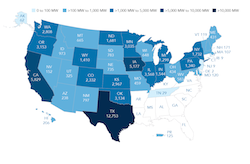According to a new report from the American Wind Energy Association (AWEA), the American wind industry is rebounding. During 2014, there was four times more new wind energy installed or coming online than in 2013. There was 4,850 MW in generating capacity installed with total installed capacity increasing by eight percent to 65,875.
However, AWEA notes that this amount still falls short of the record 13,000 MW installed in 2012 and blames failing to reach the record due to federal policy uncertainty. The renewable energy Production Tax Credit (PTC) was only extended for two weeks at the end of last year, and has now expired again. Tom Kiernan, AWEA CEO notes that every other energy source receives some type of tax relief and wind should not be, well, left in the wind.
“Wind is gaining strength, but as recent history shows, we can do a whole lot more,” said AWEA CEO Tom Kiernan. “We’re looking forward to working with Members of Congress from both sides of the aisle so that a reasonable, responsible tax policy is in place that allows the wind industry to continue lowering costs and investing billions of dollars in U.S. communities.”
Jonathan Weisgall, Vice President for Legislative and Regulatory Affairs of the Berkshire Hathaway Energy Co., told reporters that the $1.9 billion wind farm his company is building in Iowa is the largest economic development project in  the state’s history. When finished, it will pay farmers $3 million a year for land leases, and supply customers such as Google, Facebook, and Microsoft that have committed to buying clean energy.
the state’s history. When finished, it will pay farmers $3 million a year for land leases, and supply customers such as Google, Facebook, and Microsoft that have committed to buying clean energy.
“Our customers want wind,” Weisgall said. “We like wind because it’s a hedge against fossil prices…and wind, with no fuel costs associated, can keep those rates stable.”
The PTC provides a tax credit of 2.3 cents per kilowatt-hour generated for the first 10 years of a project’s life. It has encouraged $125 billion dollars of investment across America, creating 500 U.S. manufacturing facilities and technological innovations that lowered the wind power’s costs by more than half in the last five years.
“The PTC has helped the U.S. build some of the best infrastructure the country has ever seen,” Kiernan added. “As President Obama mentioned this past week [SOTU], we’ve been so successful that the U.S. is now number one in the world in wind energy production. U.S. wind farms now provide enough power for the equivalent of 18 million typical American homes.”
Nearly 30,000 well-paying jobs and tens of billions of dollars in private investment were lost due to the PTC lapse at the beginning of 2013, the last time Congress allowed the credit to expire even briefly. Wind installations plummeted 92 percent in 2013 amid the uncertainty. A multi-year extension now would enable the industry to continue lowering costs, further expanding the benefits wind energy provides to consumers.
According to AWEA, American wind power now supports well-paying manufacturing jobs at over 500 manufacturing facilities in 43 states, and an average of 73,000 total jobs over the past five years. Investment in new U.S. wind farms has driven an average of $12 billion a year in private investment over the last five years. Wind farms deliver over $180 million a year to landowners in lease payments, with over 98 percent located on private land.
A forthcoming Department of Energy report, Wind Vision, due for release this spring, shows wind could double to supply 10 percent of the nation’s electricity demand by 2020, double again to reach 20 percent by 2030, and hit 35 percent by 2050.

